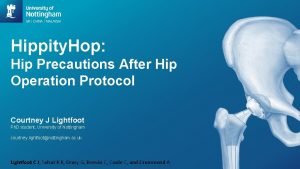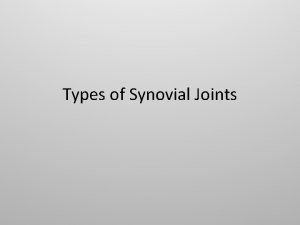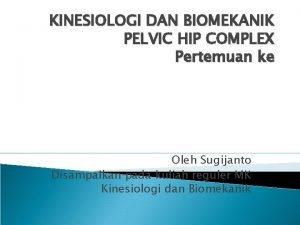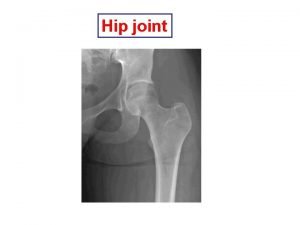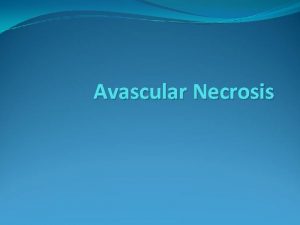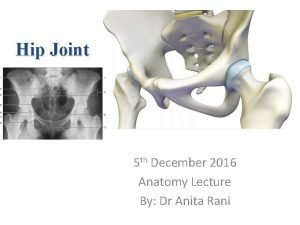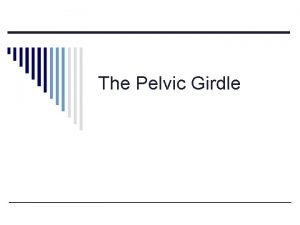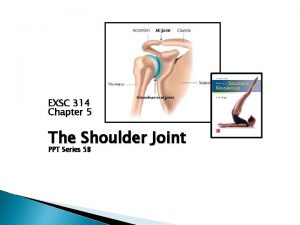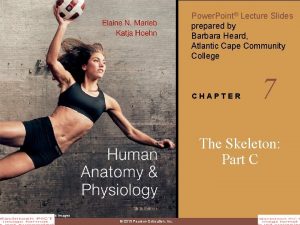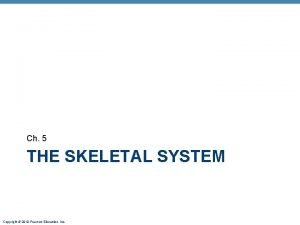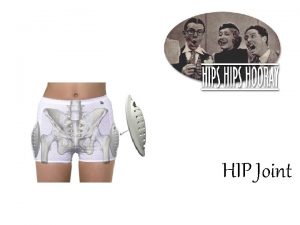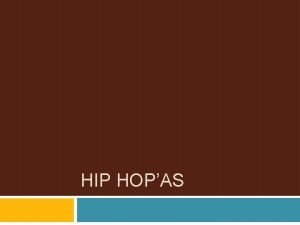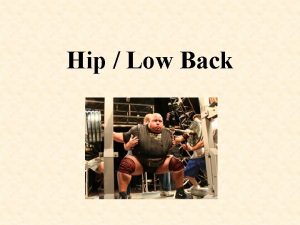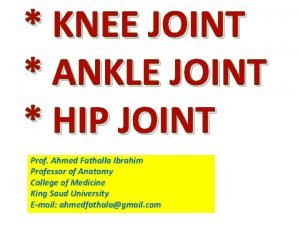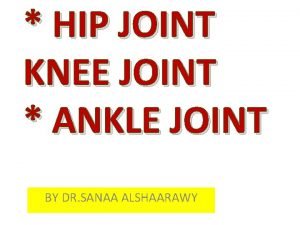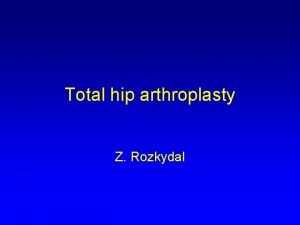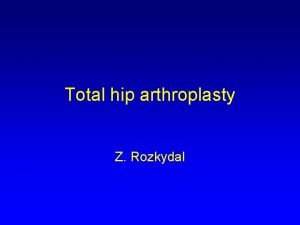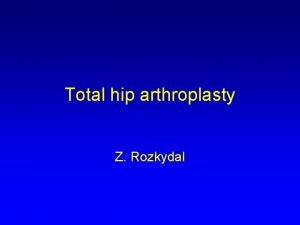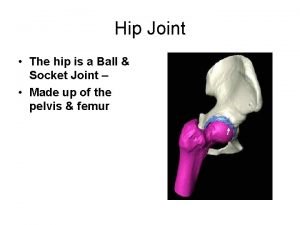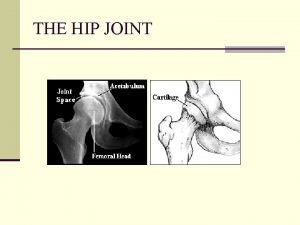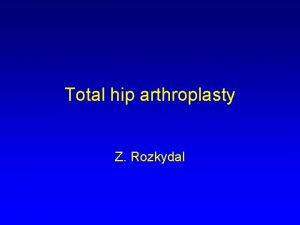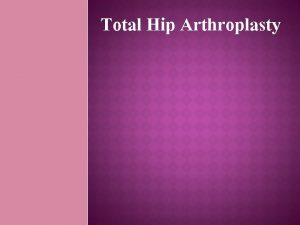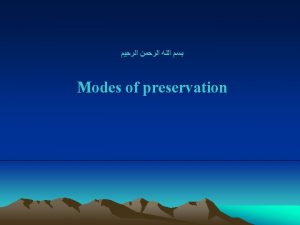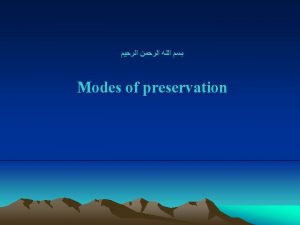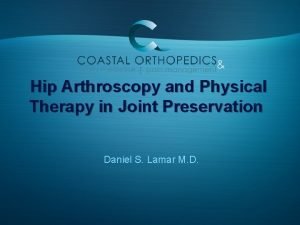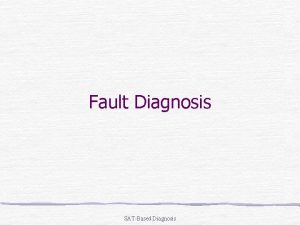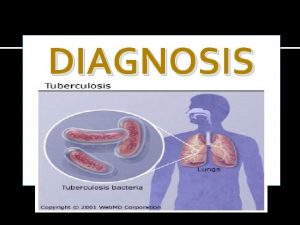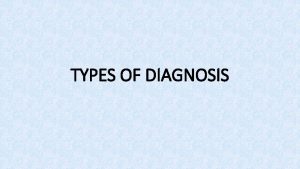Making the Right Diagnosis Symposium Joint Preservation Hip





































![Radiographic Indices: Mechanical Retroversion Diagnosis (15 -20 anteversion) o <15 o [nml >25 o] Radiographic Indices: Mechanical Retroversion Diagnosis (15 -20 anteversion) o <15 o [nml >25 o]](https://slidetodoc.com/presentation_image/197da6cd72a4a4cf1161788bb9b1eb0e/image-38.jpg)









- Slides: 47

Making the Right Diagnosis Symposium: Joint Preservation Hip Surgery – How to Avoid and Treat Complications and Failures Wednesday, February 16 th, 2011 Bryan T. Kelly, MD Co-Director Center for Hip Pain and Preservation

Bryan T. Kelly, MD Hospital for Special Surgery Disclosure: I DO NOT have a financial interest in any commercial products or service presented in this lecture AND DO NOT INTEND to discuss off label or investigational use of products or services.

Types of financial relationships and the companies with whom I have relationships are as follows: Pivot Medical, Inc. : Consultant Smith & Nephew: Educational Consultant A 2 Surgical: Consultant

Diagnostic Dilemma Origin of hip pain can be difficult to identify MUST DISTINGUISH BETWEEN INTRA - AND EXTRA-ARTICULAR PAIN

“Intraarticular Disorders” • Labral Tears – – • Hypertrophic tears (dysplasia) Hypotrophic labra Chondral Injury – – • Focal chondral defects AVN Ligamentum Teres Tears – – Partial Complete • Femoroacetabular Impingement – CAM – Pincer • Synovitis • Loose Bodies • Tumors – Synovial chondromatosis – PVNS

“Extraarticular Disorders” • Capsular Problems – – • • Pubic Pain – – – Hip Instability Adhesive Capsulitis Osteitis Pubis Chronic adductor strain Sports Hernia Snapping Hip – – • Internal Snapping Hip External Snapping Hip Lateral Hip Pain – – Recalcitrant Trochanteric Bursitis Gluteus Medius / Minimus Tears • Tendonitis / Avulsion Injuries • Nerve Compression • • • Meralgia Paresthetica (LFCN) Piriformis Syndrome (Sciatic n. ) Ilioinguinal n. Iliohypogastric n. Genitofemoral n.

History & Physical Exam

History • Mechanism of Injury: • Duration of Pain: – Location of pain: • Primary • Secondary • Aggravating Activities – – Sitting Standing Walking Sports • Clicking / Catching / Locking – Internal (Psoas) – External (ITB) – Intraarticular • Previous Surgery: – – – Hip Arthroscopy Pelvic Osteotomy Open Hip Dislcoation Hernia Surgery Back Surgery Others • Physical Therapy: – Duration – Improvement ( Yes / No )

Minimum Clinical Exam • Limp ( Yes No ) • BMI • ROM: – IR @ 90 degrees flexion – – – Flexion External Rotation Extension Abduction in supine position Craig’s Test • Provocative Pain – Impingement (FADIR) – Sub-Spine Impingement Sign (Anterior Pain with Flexion) – Superolateral impingement (Anterolateral pain with flexion / ER) – Trochanteric Pain Sign (Posterolateral pain in FABER) – Lateral Rim Impingement (Pain with abduction) – Instability (Extension / ER with Anterior Pain) – Posterior Impingement (Extension / ER with Posterior Pain) – Ischio-Femoral Impingement Sign (Post pain with Ext / IR)

Normal Passive Hip ROM • Adduction 30˚ • Abduction 45˚ • Flexion 110˚ • Extension 0˚ • IR 30˚ • ER 50˚

How do you assess ROM • IR Block Test

Provocative Pain tests • Impingement test • Flexion, adduction, internal rotation • Anterior or anteromedial pain with anterior and anterolateral impingement

Provocative Pain tests • Subspine Impingement Sign • Straight Flexion • Anterior pain from inferior impingement or sub-spine impingement

Provocative Pain tests • Superolateral Impingement • Flexion, external rotation • Anterolateral pain with superior or superolateral impingement

Provocative Pain tests • Trochanteric Pain Test • Flexion, abduction, external rotation • Posterolateral pain from trochanteric irritation

Provocative Pain tests • Lateral Rim Impingement • Straight Abduction with neutral rotation • Lateral pain from lateral rim impingement

Provocative Pain tests • Instability Test • Extension, external rotation • Anterior hip pain

Provocative Pain tests • Posterior Impingement • Extension, external rotation • Posterior hip pain

Minimum Clinical Exam • Strength – Hip Flexion – Adduction – Abduction • Palpation Pain – – – – Central Pubic Resisted Sit-Up ASIS Hip Flexors Abductors Adductors Proximal Hamstrings – Ischium • Peritrochanteric Space Exam – Pain over trochanter • Anterior • Lateral • Posterior – Weakness in Abduction • Knee Extended • Knee Flexed – Snapping

COMPREHENSIVE EXAMINATION OF THE ADULT HIP • Five points for five body positions – – – STANDING SITTING SUPINE LATERAL PRONE • ADDITIONAL TESTS AS NEEDED

STANDING EXAMINATION • General – • Laxity, Body Habitus, Posture Gait – Swing, Stance, Foot Progression, Pelvis • Spine – • Lateral, Posterior, Scoliosis, Lordosis Pelvis – • Shoulder height, Iliac Crest Trendelenburg Test – Positive, Shift or Weakness

STANDING EXAMINATION • Gait a. b. c. d. Trendelenburg Abductor lurch Antalgic Foot progression angle a. b. e. Excessive External Rotation Excessive Internal Rotation Short Leg Limp

STANDING EXAMINATION • Trendelenburg Test – Weak abductors lead to the pelvis dropping to the unsupported side • With Compensation – Severe weakness the pt is unable to lift the opposite side without leaning toward the wt bearing limb to decrease the moment arm.

SEATED EXAMINATION • Neurologic – • Circulation – • • • DTRS, Sensory, Motor, Straight Leg Raise DP, PT, Popliteal Skin Lymphatic IR/ER

SUPINE EXAMINATION • Passive ROM – Flexion, Abduction, Adduction, IR, ER • Strength Testing – Flexion, Adduction, Abduction • Provocative Pain Test • Pubalgia Testing • Special Tests – Thomas Test – Patrick / Faber’s – Instability Test (extension / ER)

LATERAL EXAMINATION • Palpation GT, ABDUCTORS, SI, ISCHIAL BURSAE • Obers Test FLEXION, EXTENSION • Passive / Active ROM MEDIUS / MAX • FADDIR IMPINGEMENT • Lateral Rim Impingement

Palpation 1 SI 2 Greater Trochanter Medius, Minimus Maximus origin 3 Ischial Tuberosity 4 Piriformis

Lateral Hip Anatomy Gluteus Medius Gluteus Minimus

Dwek J. Pfirrmann C. Stanley A. Pathria M. Chung CB. MR imaging of the hip abductors: normal anatomy and commonly encountered pathology at the greater trochanter. Magnetic Resonance Imaging Clinics of North America. 13(4): 691 -704, vii, 2005 Nov • 4 facets, 3 have distinct insertions

OBERS TEST ILIOTIBIAL BAND IN EXTENSION

Obers in Flexion Tight Maximus contribution Touch the table o/3 3=above neutral

Grade 0/5

Active ABD Medius vs Max Strength Grade 0/5

PRONE EXAMINATION • Craig’s Test – Femoral anteversion • Ely’s – Rectus Femoris Contracture • Hyperextension – Lumbar Spine • Palpation – Paravertebral muscles, spinous process

Anteverted 82. 6% Retroverted 17. 2% Craigs Test Elys

Anatomic Approach to Evaluation of the Non. Arthritic Hip • History • Clinical Exam • Radiographic / Mechanical Diagnosis • Intra-articular Damage Pattern – MRI / Arthrogram – Intra-operative findings

Layer 1: Osteochondral Layer Structures: Femur, Pelvis, Acetabulum Purpose: Joint congruence and normal osteo / arthro kinematics • Dynamic Impingement – Cam Impingement – Rim Impingement – Femoral Retroversion – Femoral Varus • Static Overload – Acetabular Dysplasia – Femoral Anteversion – Femoral Valgus
![Radiographic Indices Mechanical Retroversion Diagnosis 15 20 anteversion o 15 o nml 25 o Radiographic Indices: Mechanical Retroversion Diagnosis (15 -20 anteversion) o <15 o [nml >25 o]](https://slidetodoc.com/presentation_image/197da6cd72a4a4cf1161788bb9b1eb0e/image-38.jpg)
Radiographic Indices: Mechanical Retroversion Diagnosis (15 -20 anteversion) o <15 o [nml >25 o] >15 o [nml <10 o] >140 or <120 Alpha Angle >50 o 7. 2 mm Nml=11. 6

CT-Scan: Mechanical Diagnosis

Layer 2: Inert Layer Structures: Labrum, joint capsule, ligamentous complex, ligamentum teres Purpose: Static stability of the joint • Labral Injury • Cartilage Injury • Capsular Injury – Instability – Adhesive capsulitis

MRI

Layer 3: Contractile Layer Structures: All musculature including lumbosacral musculature Purpose: Dynamic stability • Athletic Pubalgia • Abductor Failure / Pain/ ITB • Proximal Hamstring Syndrome • Hip flexor tendonitis • Psoas dysfunction • Paraspinal dysfunction

Layer 4: Neuromechanical Layer Structures: TLS Plexus, Lumbopelvic structures, LE structures Purpose: Neuromuscular linking and functional control of the entire segment as it functions within its environment • Nerve compression syndromes • Pain syndromes • Neuromuscular dysfunction • Spine referral patterns

Neuromuscular Research Laboratory Patient Selection University of Pittsburgh Hip loaded pelvis usually rotates over fixed femur creating anterior and medial forces with rotary moments

LABRAL TEARS • Combine these forces with dynamic or static overload to the joint…

Treatment Plan The location and quality of the pain should correspond to the mechanical diagnosis and primary and secondary injury patterns. If they do, then correcting the mechanical problems and primary and secondary injuries should lead to a good outcome….

Thank You
 Right product right place right time right price
Right product right place right time right price Family time
Family time Hip hop hip to the hippity
Hip hop hip to the hippity Hip hippity hop
Hip hippity hop The right man on the right place at the right time
The right man on the right place at the right time Coracohumeral
Coracohumeral Suspension therapy for lower limb
Suspension therapy for lower limb Eksternal rotasi hip
Eksternal rotasi hip Pubofemoral ligament
Pubofemoral ligament X-ray hip joint
X-ray hip joint Ligamentum teres
Ligamentum teres Pelvic extension
Pelvic extension Hip bone lateral view
Hip bone lateral view Teres minor abduction
Teres minor abduction Potential nursing diagnosis
Potential nursing diagnosis Medical diagnosis and nursing diagnosis difference
Medical diagnosis and nursing diagnosis difference Types of nursing diagnosis
Types of nursing diagnosis Nursing process and critical thinking
Nursing process and critical thinking Perbedaan diagnosis gizi dan diagnosis medis
Perbedaan diagnosis gizi dan diagnosis medis Right hand posterior view
Right hand posterior view Right hip bone
Right hip bone Break joint lamb
Break joint lamb Nuchal ligament
Nuchal ligament Permanent and temporary welding
Permanent and temporary welding Memorandum joint venture
Memorandum joint venture Lamb grading chart
Lamb grading chart Depression movement
Depression movement Is making inference simply making a guess
Is making inference simply making a guess War making and state making as organized crime
War making and state making as organized crime Transition peg for a left turn
Transition peg for a left turn Left left right right go turn around
Left left right right go turn around You put your right foot in you put your right foot out
You put your right foot in you put your right foot out Left left right right go go go
Left left right right go go go Hát kết hợp bộ gõ cơ thể
Hát kết hợp bộ gõ cơ thể Slidetodoc
Slidetodoc Bổ thể
Bổ thể Tỉ lệ cơ thể trẻ em
Tỉ lệ cơ thể trẻ em Gấu đi như thế nào
Gấu đi như thế nào Tư thế worm breton là gì
Tư thế worm breton là gì Hát lên người ơi alleluia
Hát lên người ơi alleluia Các môn thể thao bắt đầu bằng từ đua
Các môn thể thao bắt đầu bằng từ đua Thế nào là hệ số cao nhất
Thế nào là hệ số cao nhất Các châu lục và đại dương trên thế giới
Các châu lục và đại dương trên thế giới Công thức tính độ biến thiên đông lượng
Công thức tính độ biến thiên đông lượng Trời xanh đây là của chúng ta thể thơ
Trời xanh đây là của chúng ta thể thơ Mật thư anh em như thể tay chân
Mật thư anh em như thể tay chân Phép trừ bù
Phép trừ bù Phản ứng thế ankan
Phản ứng thế ankan



